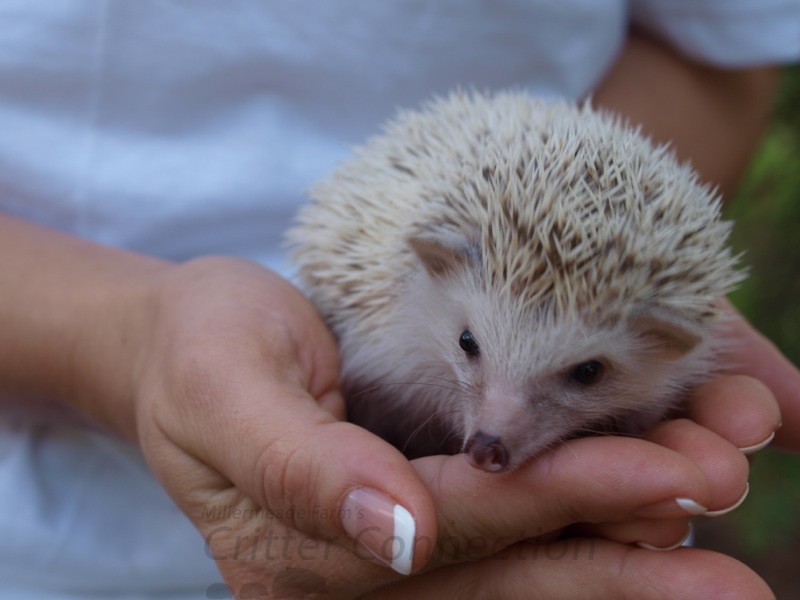Last Updated on October 29, 2022.
New Environment
- It is very common for hedgehogs to eat or drink very little the first day or two in its new home.
- Maintaining the same diet your hedgehog was fed at the breeders will certainly help your new pet adjust more quickly.
- See our article Diet Transition Guide for more information.
Temperature
- Temperatures that are too hot or too cold are a stress to your hedgehog.
- While hedgehogs in the wild are used to experiencing temperature fluctuations, pet hedgehogs in captivity do not tolerate temperature changes as well.
- A hedgehog that is too hot will lay flat on its tummy with all four legs stretched out in sort of a “splat” or “sploot” and will probably be taking quick, short breaths. Moving it to a room with recommended temperatures should slowly cool the hedgehog.
- A hedgehog that is too cold will attempt to go into hibernation, which is not natural to African Pygmy hedgehogs, and it might die if not found in time and warmed up. Your hedgehog will be in a ball and refuse to unroll or if it does unroll it will move slowly and wobble or even fall. When you feel their tummy it will be cold and clammy.
- A chilled hedgehog should be warmed up slowly and not overheated. It should then be taken to an experienced veterinarian for check up.
- See our Temperature Requirements article and Keeping Your Hedgehog Warm article for more information on this topic.
Noise
- Some breeders recommend that your new hedgehogs’ cage should not be placed in the middle of a high traffic area in order to give it some quiet space to itself.
- Your hedgehog’s usual sleeping and eating habits may become affected, if your hedgehog came from a quiet setting and your home has a lot of activity.
- Within a couple of days your new hedgehog should become accustomed to the sounds, smells, and general activity. It should then settle into its new home and become familiar with its new family.
- If a hedgehog does not experience the daily sounds and smells of its new home it may remain shy and awkward and might want to hide rather than come out to eat.
- For this reason it is important not to try and hide your hedgehog in a secluded area of your home, but to place the cage in such a way that it will include your new pet in your daily lifestyle. This way your hedgehog can quickly become comfortable with its new surroundings. It is suggested from an early age, that you begin leaving a television on with the hedgehogs that way they are used to some constant, appropriate level of noise.
- Your hedgehog will have plenty of quiet time for himself at night once everyone has gone to bed and the lights are turned out.
- You will want to keep in mind your four legged family members as well. Your new hedgehog may feel intimidated in a room with a dog that barks all day or with a cat that sits on top of its cage and stares at it all the time or tries reaching in through the wire on the cage.
- If this is happening your hedgehog may not be as inclined to come out and eat or drink.
Lights
- Although hedgehogs will sleep most of the day, they still need to have light during daytime hours, in the range of 12 to 16 hours each day.
- They also need darkness during the night so that they can come out and eat and play as they would in their natural state.
- If lights are left on all the time a hedgehog will not be as active and will not eat as much as it normally would.
- Some hedgehogs will even refuse to come out of hiding unless it is totally dark. This will depend on how the hedgehog was raised and its individual comfort level with its surroundings.
Travel
- It is completely normal for hedgehogs not to eat or drink during transit. Most hedgehogs will wait until they are not in motion and are settled into their surroundings before they venture out of their ball to eat.
- If you decide to bring your hedgehog with you on vacation or take it to your neighbor’s house while you are gone, it can be stressful for your pet.
- Keep your hedgehog in its own cage and take his regular food along, so that it has some familiar surroundings.
- It would be a good idea to pack a thermos with the water that your hedgehog is used to drinking and keep it chilled in a cooler with ice or in a refrigerator.
- If you have someone else to babysit your hedgehog make sure they know how to care for it properly, what to look out for, and have a phone number to reach you and your veterinarian in case of an emergency.
Other Things to Consider
- Even though your hedgehog lives inside your home with you, the weather outside can still affect your pet.
- It has been noted by many breeders and owners that their hedgehogs will not eat as much when a large change in barometric pressure takes place (in other words, a significant change in the weather).
- Pregnant female hedgehogs typically will not eat the day or evening before they give birth.
- After the birth of the babies, the mother will usually stay in the nest and will not come out to eat for a couple of days so we make certain the food and water are fresh.
VIDEO.: https://youtu.be/bwPtAGm8oSQ
Contributors: Gail Smith, Rebekah Scarola, Briar Patch Hedgehogs, Melissa Ramos, Coley Emde






